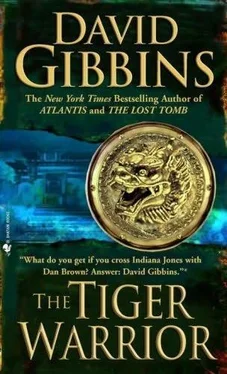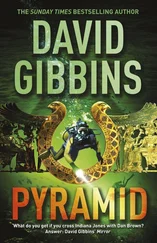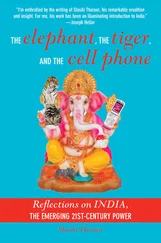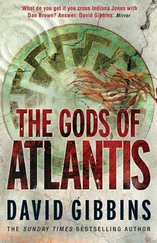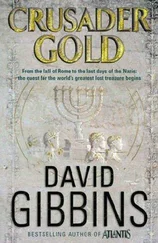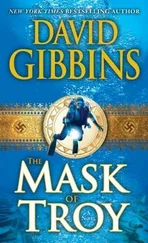David Gibbins - The Tiger warrior
Здесь есть возможность читать онлайн «David Gibbins - The Tiger warrior» весь текст электронной книги совершенно бесплатно (целиком полную версию без сокращений). В некоторых случаях можно слушать аудио, скачать через торрент в формате fb2 и присутствует краткое содержание. Жанр: Прочие приключения, на английском языке. Описание произведения, (предисловие) а так же отзывы посетителей доступны на портале библиотеки ЛибКат.
- Название:The Tiger warrior
- Автор:
- Жанр:
- Год:неизвестен
- ISBN:нет данных
- Рейтинг книги:4 / 5. Голосов: 1
-
Избранное:Добавить в избранное
- Отзывы:
-
Ваша оценка:
- 80
- 1
- 2
- 3
- 4
- 5
The Tiger warrior: краткое содержание, описание и аннотация
Предлагаем к чтению аннотацию, описание, краткое содержание или предисловие (зависит от того, что написал сам автор книги «The Tiger warrior»). Если вы не нашли необходимую информацию о книге — напишите в комментариях, мы постараемся отыскать её.
The Tiger warrior — читать онлайн бесплатно полную книгу (весь текст) целиком
Ниже представлен текст книги, разбитый по страницам. Система сохранения места последней прочитанной страницы, позволяет с удобством читать онлайн бесплатно книгу «The Tiger warrior», без необходимости каждый раз заново искать на чём Вы остановились. Поставьте закладку, и сможете в любой момент перейти на страницу, на которой закончили чтение.
Интервал:
Закладка:
– -
The Periplus of the Erythraean Sea survives as a tenth-century AD manuscript in a library in Heidelberg, copied from an original written in Greek about a thousand years earlier. It is one of the most remarkable documents from antiquity, detailing maritime trade from Roman Egypt down the African coast as far as Zanzibar, and across the Indian Ocean to the Bay of Bengal. In recent decades there has been an explosion of interest in the archaeology of the Periplus, especially with the excavation of the Red Sea port sites of Berenike and Myos Hormos. The merchant’s house in this novel is fictional, but the finds are representative of actual discoveries at these sites, including Italian wine amphoras reused as water containers, thousands of peppercorns from India, ballast stones from Arabia and India, Indian hardwood-reused ship’s timbers, including teak-and south Indian pottery. One sherd had a Tamil graffito bearing a personal name also attested in south India. Many other potsherds with inscriptions -ostraka -are known, including part of the archive at Myos Hormos of a man named Maximus Priscus. In this novel, the ostraka with the text of the Periplus, and the previously unknown section-mentioning Crassus’ legionaries-are fictional. Nevertheless, potsherds would have been a sensible writing material for a draft, before copying the final text onto papyrus.
The ancient site of Arikamedu, south of Pondicherry, was first extensively excavated by Sir Mortimer Wheeler and the Archaeological Survey of India in the 1940s, and has been the subject of renewed investigations since the early 1980s. Many still believe, as Wheeler did, that the sherds of Roman amphoras and fineware at the site indicate the presence of merchants from Egyptian ports such as Berenike-or their local agents-who traded with merchants coming across the Bay of Bengal and down from central Asia, bringing exotic goods such as silk and lapis lazuli. Divers from the Archaeological Survey of India have begun to investigate the waters off Arikamedu and other sites mentioned in the Periplus. As more archaeologists see Roman involvement with India as a two-way cultural process-with as much Indian influence on the west as the other way around-we can look forward to the discovery of more sites that represent the trade in the Periplus, one of the most extraordinary episodes of maritime endeavor the world has ever seen.
Some thirty nautical miles southeast of Cape Ras Banas in the Red Sea lies St. John’s Island (Arabic Zeberged), the only source in antiquity of the gem peridot, undoubtedly the topazai mentioned by Strabo and Pliny as the product of an island close to Berenike. One Red Sea port mentioned in the Periplus that has yet to be conclusively identified is Ptolemais Theren, “Ptolemy of the Hunts,” nor has a seagoing elephant-carrier-an elephantegos-yet been found. Neverthless, several Roman wrecks containing wine amphoras are known in the Red Sea, very possibly ships destined for Arabia and India. The Periplus specifically mentions gold and silver coins as the main Roman export-for trade on the Malabar coast we are exhorted to take coin, “a great deal of it”-and this is consistent with the emperor Tiberius’ lament about the bullion drain (Tacitus, Annals, iii, 54; also Pliny, Natural History vi, 101; xii, 84), as well as with the discovery of many thousands of gold and silver coins in south India. There can be no doubt that a Roman wreck will one day be discovered in the Red Sea or the Indian Ocean with a wealth of gold to rival the treasure wrecks of the Spanish Main.
The Rampa Rebellion of 1879-81 was the largest uprising of tribal people to occur in central India during the period of the British Raj, and was put down by a brigade-sized expedition of the Indian army. The immediate cause of the rebellion was a tax on toddy, the alcoholic drink made from palm sap, though the backdrop included discontent over forestry regulations and the corruption of the native police. It was a protracted campaign, beset by the terrible “jungle fever,” and its history has never been properly written. The picture here is based on daily reports in the Madras Military Proceedings and Madras Judicial Proceedings, private correspondence, regimental records and biographical information on the British officers involved (in some contemporary accounts, “Rampa” appears as “Rumpa,” a more phonetical spelling). There are no known personal reminiscences of the campaign, though a sense of the language and outlook of a Royal Engineers officer on a jungle campaign in the 1870s can be gleaned from Lieutenant R G. Woodthorpe’s The Lushai Expedition 1871-1872, describing a punitive expedition into Burma. The dramatic events early in the Rampa Rebellion were reported in the London Times and The New York Times, including the attack on the steamer Shamrock by over one thousand rebels and Lieutenant Hamilton’s fight in the jungle, but interest waned as the rebellion dragged on and became mired in disease and monsoon. The wording of Hamilton’s account is taken from his report of 20 August 1879 in the Madras Military Proceedings, showing that his sappers expended 1050 rounds and killed at least ten rebels. Surgeon Walker’s description of the jungle fever in chapter 5 is taken from a report by Surgeon-Major J. Bilderbeck, Thirty-sixth Madras Native Infantry, in May 1880, when all of the British officers and three-fifths of the sepoys in his regiment were struck down. The Koya treated fever with the remedy described in chapter 9 (Note on the Rampa Agency, East Godavari District, Madras, 1931, p. 31). Rampa district today remains little changed from the 1880s, and the jungles of eastern India are a haven for Maoist terrorists as well as attracting mining prospectors backed by foreign investment.
An account from 1876 describes the sacred velpus, including the potent Lakkala (or Laka) Ramu. The velpus were bamboo tubes, kept hidden away. The animistic spirits of the jungle, the konda devata, included a tiger god. The Godavari volume of the Imperial Gazetteer of India notes that near Rampa village, “beside a waterfall about 25 feet high, is a shrine formed of three huge boulders, two of which make a kind of roof, and fitted with a doorway and one side-wall of cut stone. The water of the fall pours continually between the boulders. A rough lingam and other holy emblems have been carved out of the rock.” In my fictional shrine, the Indian iconography is based on cave carvings at Badami and sculpture elsewhere in India, including the yaksas and yaksis figures. The Rampa shrine is where several police captives were executed in 1879. A native eyewitness described one “sacrifice”: “Chendrayya himself cut off his head with a sword. They sacrificed him to Gudapu Mavili.” (Madras Judicial Proceedings, 5 September 1879). Other accounts describe “meriahs” being sacrificed or rescued, and headless bodies being found. The riverside sacrifice scene is a fictional representation of these events, and derives further detail from eyewitness accounts of human sacrifices recorded in Major-General John Campbell’s A Personal Narrative of Thirteen Years Service amongst the Wild Tribes of Khondistan for the Suppression of Human Sacrifice (1864)-including Captain Frye’s rescue of a meriah, quoted here in chapter 4-and from Christoph and Elizabeth von Furer-Haimendorf’s The Reddis of the Bison Hills: A Study of Acculturation (1945), one of few detailed anthropological studies of the hill tribes of the upper Godavari.
Several of the characters in this novel are based on actual individuals in the Rampa Field Force, some with names altered. Joseph Fawcett Beddy was assistant commissioner for the Central Provinces, and accompanied Hamilton during his affray in the jungle. The official report on the rebellion to the Government of India states that Beddy “died from fever” after the affray (Madras Judicial Proceedings, 14 December 1881); but his tomb inscription at Wuddagudem recorded that he was “shot in the late Rampa Rebellion” (H. Le Fanu, List of European Tombs in the Godaveri District with Inscriptions Thereon, Cocanada 1895). Dr. George Lemon Walker, Surgeon to D and G Companies, Madras Sappers and Miners, during the Rampa Rebellion, was indeed born in Kingston, Canada, and received his medical training at Queen’s University in Belfast. From 1884 his superior in medical charge of the Madras Sappers was Surgeon-Major Ronald Ross-later Sir Ronald Ross, famous for identifying the Anopheles mosquito as the carrier of the malaria parasite, and whose patients would have included sapper veterans of Rampa suffering from the dreaded “jungle fever.”
Читать дальшеИнтервал:
Закладка:
Похожие книги на «The Tiger warrior»
Представляем Вашему вниманию похожие книги на «The Tiger warrior» списком для выбора. Мы отобрали схожую по названию и смыслу литературу в надежде предоставить читателям больше вариантов отыскать новые, интересные, ещё непрочитанные произведения.
Обсуждение, отзывы о книге «The Tiger warrior» и просто собственные мнения читателей. Оставьте ваши комментарии, напишите, что Вы думаете о произведении, его смысле или главных героях. Укажите что конкретно понравилось, а что нет, и почему Вы так считаете.
